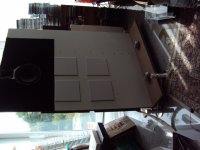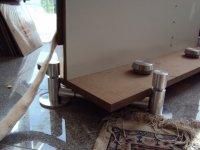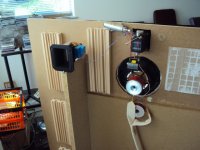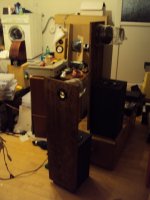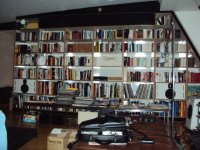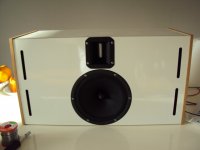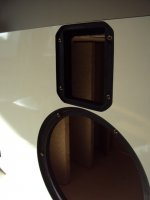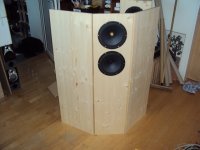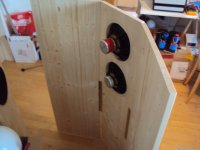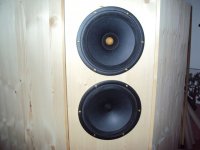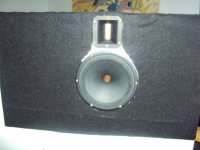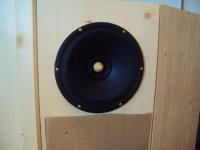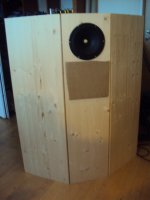Hallo Joachim,
my best way to decouple is:
placing a heavy concrete slab (the normal garden Walk-path type) on a piece of
thick rug in your room and using adjustable spikes between LS and the slab is a cheap,
worthwhile solution. if the box weight is over 20 kg ,small rubber damped
"Möbelgleiter" four for 1 € are enough.
""hearing" is believing - instead of "seeing"" das ist hart Rudolf.
Wir drei sollten uns zusammentun und für MediaMarkt eine
Eigenmarkenentwicklung anbieten!!?
my best way to decouple is:
placing a heavy concrete slab (the normal garden Walk-path type) on a piece of
thick rug in your room and using adjustable spikes between LS and the slab is a cheap,
worthwhile solution. if the box weight is over 20 kg ,small rubber damped
"Möbelgleiter" four for 1 € are enough.
""hearing" is believing - instead of "seeing"" das ist hart Rudolf.
Wir drei sollten uns zusammentun und für MediaMarkt eine
Eigenmarkenentwicklung anbieten!!?
Sorry Rudolf, but then you are blind. The green response is smoother in the bass and there is less vibration in the fundamental tone area if not at all frequencies. Tonight i will try to produce a plot that shows the difference. hm i already have a granite floor that is totally inert as you can see in the second plot. No diffence with Swingbase or without measured on the floor and i really do not think that spiking to a high mass is the correct solution.
Decouple
Yes, that is the way to go, hanging, swinging or decoupling via soft feet.
Michael has been talking about this and wrote a little summary:
Audio and Loudspeaker Design Guide Lines
It's been tested widly with just hanging speakers by Stig-Erik:
http://www.diyaudio.com/forums/multi-way/142015-my-open-baffle-dipole-beyma-tpl-150-a-83.html
There are these PU-feet with some measurements...
Sonic Design Dmpfungsfe
..and plenty more...
//Per
Yes, that is the way to go, hanging, swinging or decoupling via soft feet.
Michael has been talking about this and wrote a little summary:
Audio and Loudspeaker Design Guide Lines
It's been tested widly with just hanging speakers by Stig-Erik:
http://www.diyaudio.com/forums/multi-way/142015-my-open-baffle-dipole-beyma-tpl-150-a-83.html
There are these PU-feet with some measurements...
Sonic Design Dmpfungsfe
..and plenty more...
//Per
I made some changes on my MPL baffels. One is the inclusion of the Bönicke Swingbase and one is the addition of a back firing Ribbon Tweeter. Let me tell you right away that i am not prepared to go into any agressive discussion about the benefits of the changes i make. MPL means "My PRIVAT Loudspeaker" so if it pleases me, so be it. I can measue and hear the diffence the Swingbase makes and i could publish more measurements, for example tone bursts in the bass range but i decided agains it because i already realise that some people will agree and some not, whatever i do. The adittion of the back tweeter was a mixed blessing at first. It sounded like a light was switched on and i could here much new detail that have not been there before. For example when a bell was struck i could now claerly hear the reverberant tail. On the other hand especially female voices developped a sharpness that bordered on colouration although it was too high in frequency to sound hollow or nasal. I whould be hard pressed to describe it but voices of seasoned jazz singers got a lightness of tone that i do not know from life concerts. It was fascinating at first but fatique set in after about 20 minutes. I think today i found a solution by lowering the amount of treble in the back by ca. 2 to 3dB. I also included an on-off switch and another resistor that allows me to lower by ca. 1dB. The sound i now get is more transparent then without the aditional tweeter but without affecting the upper tonal range of a female singer. This is a work in progress so more information may be published in the future. See pictured of the Bönicke Swingbase and the aditional tweeter.
Attachments
Hi Joahim. I have some theoretical thoughts about your MPL.
- Did you try to lower amount of treble on BOTH drivers instead of lowering just back radiation ?
- don't you think that in your case you'd get better results with no-horn version of your ribbon ? I'm guessing that it would blend better at the back of the baffle regarding to both drivers' off axis radiation. Aditionally you get about -3db from plain ribbon.
- Did you try to lower amount of treble on BOTH drivers instead of lowering just back radiation ?
- don't you think that in your case you'd get better results with no-horn version of your ribbon ? I'm guessing that it would blend better at the back of the baffle regarding to both drivers' off axis radiation. Aditionally you get about -3db from plain ribbon.
Hi Fakamada ! All very good ideas. In the front i need the horn ribbon out of reasons i have expained before and the back ribbon is still experimental. Maybe i was i bit naiv thinking i should use the same in the back. Currently i get a very good result with a 3.9 Ohm resistor in front of the back ribbon and the same crossover components then the front ribbon. The sound is more open and spacious with a longer and more natural reverberation tail without thinning voices. I whould also like to experiment with a baffle, maybe from felt around the back ribbon. I have a feeling that it should extend a little lower.
I will attend the ETF festival in november and i was invited to hold a seminar about my work with open baffles. I will prepare some slices including the motivation and realisation of the G-Pole principle. I also intend to wright an article for Linear Audio Volume 1 where i describe a DIY G-Pole with fitting M-Frame subwoofers. Sorry that i do not post any circuits or drawings right now but more details will be revealed over the next month.
Here is the ULR to the ETF festival :
European Triode Festival - ETF 2010 Program
Here is the ULR to the ETF festival :
European Triode Festival - ETF 2010 Program
I have published some measurement using the Bönicke Swingbase on my MPL baffles some time ago. The MPL baffles stand on the granite-concrete floor of my purpose build listening room so especially the measurement that show energy transfer to the floor did not come out very convincing for some. I could show a reduction of vibration on the baffles but again some found that too little to have an impact on the sound. Trust me, it does improve the sound but even Sven Bönicke thought that this measurements are not entirely satisfying. So i repeated the measurement, this time using a more conventional 2-way floorstander in the style of a Sonics Allegretto and i put them on the wooden maple floor of my lab. Here are the results.
Attachments
The widerange is a Fountek FR88 and the bass is an older VIFA with wood fiber enforced paper membrane. I will publish the schematic. I am still working on it.
I used some "tricks". One is a 4.7 Ohm resistor in series with the woofer and also a 470uF cap. That way i can extent the bass in a closed box by using a driver that is designed for a reflex cabinet. I could afford the sensitivity loss because the FR88 has only 84.5dB @ 1 W, 8Ohm. The woofer crosses over around 250Hz but the crossover has a wide overlap.
I reversed the phase in the bass and the bass firing upwards has a lot of room interaction so i can not answer if they blend well before i have listened to it.
I used some "tricks". One is a 4.7 Ohm resistor in series with the woofer and also a 470uF cap. That way i can extent the bass in a closed box by using a driver that is designed for a reflex cabinet. I could afford the sensitivity loss because the FR88 has only 84.5dB @ 1 W, 8Ohm. The woofer crosses over around 250Hz but the crossover has a wide overlap.
I reversed the phase in the bass and the bass firing upwards has a lot of room interaction so i can not answer if they blend well before i have listened to it.
Ribbon XO
Hi. Any work in progress on big MPLs ?
I have a question about horn ribbon. I'm about to begin experiments with blending it with a 6.5" fullrange (with whizzer) and I'm curious about the ribbons power handling.
How low can you go with 1order without the risk of destroing the ribbon ?
I'm planning to cross around 7khz because my fullrager has a peak at 6khz but I'm curious if I'm allowed to try it litte lower.
What cap values do you use/used/suggest ?
Hi. Any work in progress on big MPLs ?
I have a question about horn ribbon. I'm about to begin experiments with blending it with a 6.5" fullrange (with whizzer) and I'm curious about the ribbons power handling.
How low can you go with 1order without the risk of destroing the ribbon ?
I'm planning to cross around 7khz because my fullrager has a peak at 6khz but I'm curious if I'm allowed to try it litte lower.
What cap values do you use/used/suggest ?
fakamada, the ribbon horn i am using is robust so you can try a lower crossover. I use second order electrically.
The 20cm wideband unit i am using got a sister and a brother. There is now a woofer with longer coil and Neodymium magnet and a full range version with wizzer cone. I put the drivers in a spruce baffle with movevable hinges. Looks kind of Betsi, i know, but it works different. I will try to blend in the woofer to compensate the baffle step. I made some first measurements but i am not totally satisfied yet. Stay tuned.
The 20cm wideband unit i am using got a sister and a brother. There is now a woofer with longer coil and Neodymium magnet and a full range version with wizzer cone. I put the drivers in a spruce baffle with movevable hinges. Looks kind of Betsi, i know, but it works different. I will try to blend in the woofer to compensate the baffle step. I made some first measurements but i am not totally satisfied yet. Stay tuned.
Attachments
Hi Joachim. Some time ago I suggested to use NO HORN ribbon at the back of baffles. I recently took off the horn of this driver (neoCD3.5H) and it works really well without it. Adidtionally you get steeper rolloff at XO point. You can easily take it off by unscrewing 4 screws.
fakamada i did not post much about speakers recently. Some things have changed. I had to send back the Boenicke Swingbases. I am now using 6 tennis balls with no loss in sound quality. I have now fitted the final version of the wideband driver. It has a 4mm shorter coil former for more stiffness and a wider diameter spider. The phaseplug of mine is from walnut. The sound i get now is even better resolved and transparent without going spitty.
In fact i think the sound is even a bit more human and warm. That also has to do with the acoustic tuning of my room by Fast Audio. Thomas made many attempts over the years to improve my acoustics but i first found the result too dull or even a bit disturbing. That has changes dramatically the last two times he was in my room. I will tell you more later what he did but basically Thomas improved everything without overdamping the room. I like a reverb of around 600msec, mostly i agree with Linkwitz on that. Most "tuned" rooms sound too dull and artificial to me. 600msec is quite long for a monitoring room of a recording studio but my goal is different. I like to analyse my sound as much as a mixing or recording engineer does but i want my sound to be "dramatic" and full of energy. After lots of discussion with Thomas he found a solution that sounds extremely transparent and dynamic but with a human warmth and liquidity that allows me to listen to sub optimal material without disturbance but still enjoy my really well produced material. I can hear much louder now without fatigue and enjoy more music the same time. The sound also gained in "space", width, depth and height. Great Job, Thomas !
I will be experimenting with the "back horn off" and also will try the Wizzer version of the wideband driver. I had experimented with an additional woofer ( see earlier pictures ) but that was not successful. I will now use a single driver in a foldable baffle with a crossover i designed. I will publish the measurements soon.
In fact i think the sound is even a bit more human and warm. That also has to do with the acoustic tuning of my room by Fast Audio. Thomas made many attempts over the years to improve my acoustics but i first found the result too dull or even a bit disturbing. That has changes dramatically the last two times he was in my room. I will tell you more later what he did but basically Thomas improved everything without overdamping the room. I like a reverb of around 600msec, mostly i agree with Linkwitz on that. Most "tuned" rooms sound too dull and artificial to me. 600msec is quite long for a monitoring room of a recording studio but my goal is different. I like to analyse my sound as much as a mixing or recording engineer does but i want my sound to be "dramatic" and full of energy. After lots of discussion with Thomas he found a solution that sounds extremely transparent and dynamic but with a human warmth and liquidity that allows me to listen to sub optimal material without disturbance but still enjoy my really well produced material. I can hear much louder now without fatigue and enjoy more music the same time. The sound also gained in "space", width, depth and height. Great Job, Thomas !
I will be experimenting with the "back horn off" and also will try the Wizzer version of the wideband driver. I had experimented with an additional woofer ( see earlier pictures ) but that was not successful. I will now use a single driver in a foldable baffle with a crossover i designed. I will publish the measurements soon.
